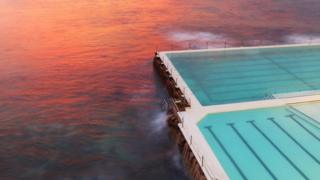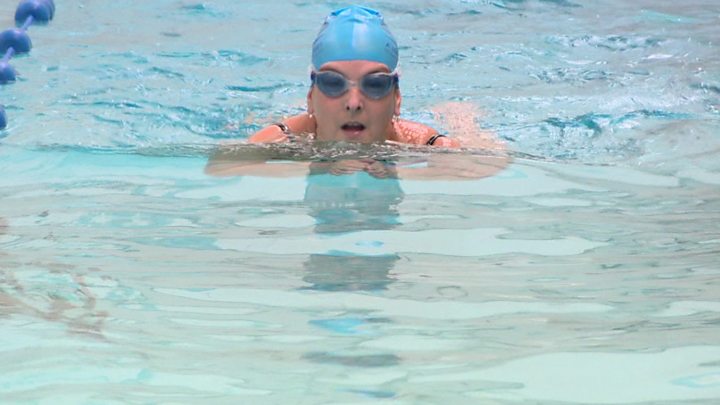Home » Australasia »
How Sydney’s pools became the envy of the world
Sydney’s outdoor pools are loved by residents and visitors alike. With one iconic swim spot getting a much-debated upgrade, Gary Nunn revisits how the city’s pool culture came about.
Beyond the famous opera house and bridge, Sydney harbours somewhat of a secret.
Its lesser-known claim to fame is that it has more ocean pools (35) than any other city in the world. Cape Town is its closest rival, boasting 19.
“Sydney’s big collection of ocean pools in one city is unique,” says Dr Marie-Louise McDermott, an expert who has written on the subject.
She defines ocean pools as man-made public seawater pools situated on a surf coast, so waves can wash over the sides.
Sydney’s ocean pools, she says, came about as a result of “rips, sharks and respectability”.
In the 19th Century, swimming costumes weren’t commonplace – people bathed nude or in clothes they didn’t care about getting wet.
“Public bathing was illegal in daylight hours, but you could bathe in private baths,” Dr McDermott says.
This led to gender-segregated bathing hours or pools. It’s why Coogee, a beachside suburb, still has McIver’s Ladies Baths, built in 1876.
Sophia Day, 27, says the ladies’ baths, where she often swims with her mother, are a space they feel safe “especially if we want to swim topless – much more liberating”.
Australian beaches often have rips – dangerous narrow currents – so ocean pools were built to improve safety before there was a surf lifesaving culture – where volunteers trained in life saving techniques patrol the beaches.
In 1911, gender segregation ended and around the same time, the public bathing ban was lifted.
This led to a higher risk of drowning, especially for women and girls who hadn’t had the same access to swimming schools as men.
“Ocean pools were an affordable way to provide safe bathing places,” Dr McDermott says.
“It was also a place to train up new surf lifesavers. The community would raise half the money, the council the other half. They were often the first community facility created for men, women and children to all use together.”
It remains a unique experience, she adds: “There can be fish, seaweed, bluebottles [jellyfish-like creatures] or a resident octopus in there with you – you have to share with them.”
What about other countries?
Dr McDermott notes Cape Town has a similar set-up to Sydney – a city within “a colonised country with a surf coast, rips and sharks”.
But many nations haven’t developed the same sea pool culture.
“The English seaside was more about being beside the sea than in it,” Dr McDermott says.
“A ‘bathing machine’ carriage would take people into the sea so they weren’t seen in a state of undress. In Australia, you couldn’t take a horse and cart into a fairly violent surf.”
In North America, meanwhile, there wasn’t the same resident-push for such aquatic public infrastructure: “Their waters were colder, not as many people used the water recreationally and there were less sharks.”
Hannah Lewi, a professor of architecture at the University of Melbourne, says Sydney’s coastline “lent itself to carving out of cliff edges, unlike Melbourne or Perth”.
She also cites Australia’s competitive swimming success as a factor. Dr McDermott agrees: “After Australia did wonderfully well at swimming in the 1956 Olympics, lots of pools made themselves Olympic sized – some got bigger, some shrank.”
Residents who love them
Ben Jordan, 37, and Lauren Hockey, 30, often visit pools since they moved to Sydney from the UK.
Ms Hockey says: “There’s no comparison – you can swim in saltwater in a sheltered spot, often with stunning vistas. Before I moved here I rarely swam. Now I try to make it weekly – often daily in summer.”
They’re also great “for those who don’t want to contest waves or worry about what lurks beneath”, she adds.
Sydney resident Andrew Ward founded Head Above Water, a group which uses pools to help manage the negative effects of poor mental health.
“I had significant issues last year with my mental health and the swimming community at [northern suburb] Collaroy were remarkably supportive,” he says.
“Any exercise is good to manage mild depression, but… there’s something about being by the sea. The rhythm helps your state of mind, makes all your senses alive.”
Sydney does have its artificial and indoor pools too.
It was recently announced that the iconic outdoor North Sydney Olympic Pool will get a $A57.9m (£32m; $41m) upgrade.
The pool, sitting beside the Sydney Harbour Bridge, was opened in 1936 and used in the British Empire Games two years later.
It’s often seen on Instagram these days, sparkling in the sun. But below the sheen, it’s leaking and the floor is raising.
Urgent renovations are afoot; North Sydney mayor Jilly Gibson says the finished product will be “a stunner – an interweaving of historic elements and contemporary design”.
But not all residents are happy.
Chris Bowden, 39, says: “I love the shabbiness and old school charm of the pool as it stands today. It has a long history, by Sydney standards.
“You can feel it as you enter the old wooden changing rooms and admire its unique art deco features. So much of Sydney is polished; it’s refreshing to retain a space which holds onto some history. Not every surface has to shine.”
Source: Read Full Article




